20702-77-6
| Name | Neohesperidin dihydrochalcone |
|---|---|
| Synonyms |
Neosperidin Dihydro halcone
NEOHESPERIDINE DC Neohesperidine hydrate 3,5-Dihydroxy-4-[3-(3-hydroxy-4-methoxyphenyl)propanoyl]phenyl 2-O-(6-deoxy-α-L-mannopyranosyl)-β-D-glucopyranoside neohesperidine dihydrochalcone Neohesperidin Dihydrochalcone Hydrate EINECS 243-978-6 1-[4-[[2-O-(6-Deoxy-a-L-mannopyranosyl)-b-D-glucopyranosyl]oxy]-2,6-dihydroxyphenyl]-3-(3-hydroxy-4-methoxyphenyl)-1-propanone Neohesperidin dc Dihydrohesperetin-7-O-neohesperidoside E-959 UNII-3X476D83QV MFCD03840557 Neohesperidin dihydrochalcone 1-Propanone, 1-[4-[[2-O-(6-deoxy-α-L-mannopyranosyl)-β-D-glucopyranosyl]oxy]-2,6-dihydroxyphenyl]-3-(3-hydroxy-4-methoxyphenyl)- NEOHESPERIDIN DIHYDROCHALONE Nhdc Neohesperidin DHC Neosperidin dihydrochalcone FEMA 3811 |
| Description | Neohesperidin dihydrochalcone is a synthetic glycoside chalcone, is added to various foods and beverages as a low caloric artificial sweetener. |
|---|---|
| Related Catalog | |
| In Vitro | Neohesperidin dihydrochalcone shows remarkable radical scavenging activity against stable radical and reactive oxygen species (ROS) in concentration dependent manner. Especially, neohesperidin dihydrochalcone is the most potent inhibitor of H2O2 and HOCl. Neohesperidin dihydrochalcone shows HOCl scavenging activity of 93.5% and H2O2 scavenging property of 73.5%. Neohesperidin dihydrochalcone shows extensive inhibitory effect especially on non-radical ROS H2O2 and HOCl with IC50 values of 205.1, 25.5 μM[1]. Neohesperidin dihydrochalcone is found to be an activator of porcine pancreatic alpha-amylase (PPA) with an IC50 of 389 μM[2]. |
| In Vivo | Neohesperidin dihydrochalcone administration results in significant reduction in activities of two useful markers of liver damage, AST and ALT. The relative levels of NF-κB, IL-6, IL-1β and TNF-α protein in the liver of PQ-treated mice are inhibited by neohesperidin dihydrochalcone[3]. The embryotoxicity/teratogenicity of neohesperidin dihydrochalcone is examined in Wistar Crl:(WI)WU BR rats. No adverse effects are observed at neohesperidin dihydrochalcone levels of up to 5% of the diet, the highest dose level tested, at which the rats consumed about 3.3 g/kg body weight/day[4]. |
| Cell Assay | WST-8 dye is used in the cell viability assay. HIT-T15 and HUVEC cells are grown and maintained in Dulbecco’s modified Eagle’s medium, supplemented with 10% fetal bovine calf serum. 1000 cells in each well are incubated with various concentrations of neohesperidin dihydrochalcone (50, 100, 500 μM, 1 mM) and other compounds. After treating HIT-T15 and HUVEC cells with 500 μM HOCl, WST-8 dye is added to each well, and the absorbance is detected at 420 nm with microplate reader[1]. |
| Animal Admin | Rats: The embryotoxicity/teratogenicity of neohesperidin dihydrochalcone is examined in Wistar Crl:(WI)WU BR rats. The study is comprised of four groups of 28 mated female rats each, i.e., a control group (0% neohesperidin dihydrochalcone) and three treatment groups (1.25, 2.5, and 5% neohesperidin dihydrochalcone). The general condition and behavior of the animals are observed twice daily. Body weight is determined on days 0, 7, 14, and 21 of gestation. Food consumption is determined during three consecutive periods (days 0-7, 7-14, and 14-21 of gestation)[4]. [3]Mice: Neohesperidin dihydrochalcone is dissolved in a 0.5% CMC vehicle. Mice are randomized into four groups. The control group receives equal volume of vehicles throughout. The PQ group receives saline once daily for 6 consecutive days. One hour after final saline treatment, mice are injected with PQ (75 mg/kg body weight). The neohesperidin dihydrochalcone group receives a daily dose of 200 mg/kg body weight by oral gavage for 6 consecutive days. One hour after final neohesperidin dihydrochalcone treatment, mice are injected with PQ (75 mg/kg body weight)[3]. |
| References |
| Density | 1.6±0.1 g/cm3 |
|---|---|
| Boiling Point | 927.1±65.0 °C at 760 mmHg |
| Melting Point | 156-158 °C(lit.) |
| Molecular Formula | C28H36O15 |
| Molecular Weight | 612.576 |
| Flash Point | 302.6±27.8 °C |
| Exact Mass | 612.205444 |
| PSA | 245.29000 |
| LogP | 3.09 |
| Vapour Pressure | 0.0±0.3 mmHg at 25°C |
| Index of Refraction | 1.684 |
| Storage condition | −20°C |
| Water Solubility | Insoluble |
CHEMICAL IDENTIFICATION
HEALTH HAZARD DATAACUTE TOXICITY DATA
MUTATION DATA
|
| Personal Protective Equipment | Eyeshields;Gloves;type N95 (US);type P1 (EN143) respirator filter |
|---|---|
| Hazard Codes | C |
| RIDADR | NONH for all modes of transport |
| WGK Germany | 3 |
| RTECS | LZ5785000 |
| HS Code | 2932999099 |
| Precursor 0 | |
|---|---|
| DownStream 1 | |
| HS Code | 2932999099 |
|---|---|
| Summary | 2932999099. other heterocyclic compounds with oxygen hetero-atom(s) only. VAT:17.0%. Tax rebate rate:13.0%. . MFN tariff:6.5%. General tariff:20.0% |


